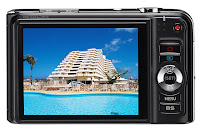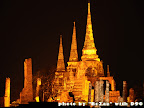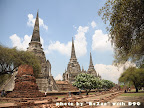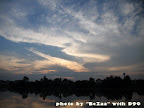21.1 Megapixel Full-frame CMOS sensor, 14-bit A/D conversion (16,384 colors/each of 3 primary color), wide range ISO setting of 100-6400 (expandable L: 50, H1: 12800 and H2: 25600).
The EOS 5D Mark II features a huge, full-frame sensor. A 21.1-megapixel CMOS sensor delivers images of up to 5616 x 3744 pixels. And since it is full-frame, all lenses will deliver the angle of view they would on a 35mm camera without a conversion factor. This comes in handy especially when shooting with wide-angle lenses. For the flexibility to shoot in even the most dimly lit situations, the EOS 5D Mark II offers Canon's highest ISO sensitivity to date, ranging from 100-6400 (expandable to ISO L: 50, H1: 12800 and H2: 25600). Thanks to improved noise reduction technologies, images shot even at highest sensitivity will be remarkably smooth.
HD Video Shooting with Live View Function.
Full HD Video capture at 1920 x 1080 resolution for up to 4GB per clip with HDMI output for HD viewing of stills and video.
The EOS 5D Mark II is the first digital EOS to offer recording of Full HD video in Live View Mode. Capable of shooting clips almost half an hour long at full 1080 resolution, the EOS 5D Mark II does amazing double duty, making it possible to shoot broadcast quality video on your camera by simply changing settings. The advantages move way beyond the ability to shoot on your SLR - the wealth of high-speed lenses and shooting accessories that make EOS photography so remarkable can be used in shooting video. Where interchangeable lens video cameras cost thousands of dollars, with the EOS 5D Mark II their operation, including HDMI output, is simply an added bonus to a remarkable camera.
- Next generation DIGIC 4 Image Processor for faster processing of fine detail and color reproduction as well as reduced image noise.
State-of-the-Art Image Processing with Power and Speed.
Next generation DIGIC 4 Image Processor for faster processing of fine detail and color reproduction as well as reduced image noise.
The EOS 5D Mark II's sensor is backed up by Canon's DIGIC 4 Image Processor, which speeds up all operations making a number of new features possible. Processor intensive operations like Face Detection Live mode, HD video recording and lighting and lens peripheral optimization are all possible thanks to the DIGIC 4 Image Processor. The EOS 5D Mark II also offers full 14-bit A/D conversion. The analog output from the image sensor is converted into a digital signal via 14-bit conversion instead of the previously used 12-bit conversion, resulting in significantly finer tonal gradation for better prints.
DIGIC 4 Image Processor
Developed to maximize performance between capturing and recording stages of digital photography, Canon's DIGIC 4 chips use advanced signal processing technologies to enhance captures from Canon's CMOS sensors. Sophisticated processing algorithms help to speed up all operations, including write times to UDMA cards.
Lens Peripheral Illumination Correction
Canon's exclusive Lens Peripheral Illumination Correction takes into account any light falloff in the corners of the frame and corrects it, making for a perfectly exposed image. Correction data are detected automatically on a number of Canon lenses and can be entered manually through included Canon EOS Utility software.
- High performance with 3.9 fps continuous shooting, new shutter with a durability of 150,000 cycles and improved weather-resistant body.
Cutting-Edge Autofocus.
High performance with 3.9 fps continuous shooting, new shutter with a durability of 150,000 cycles and improved weather-resistant body.
The EOS 5D Mark II has a sophisticated AF system consisting of 9 user-selectable AF points, along with a total of 6 additional vertical and horizontal AF assist points. The central AF point is cross-type, and is sensitive to vertical lines at an aperture of f/2.8, horizontal lines at f/5.6. The AF system is also sensitive to its light source, and can compensate for focus errors that can occur when multiple sources illuminate a scene. AF points can be chosen by the photographer using the 5D's multi-controller or preferred control dial. Plus, the EOS 5D features a dedicated AF ON button.
The EOS 5D Mark II has a rugged new shutter designed to withstand 150,000 exposures. Combined with its impressive build quality, this new shutter ensures that the EOS 5D Mark II will thrive in challenging shooting environments.
- Live View Function for stills (Quick, Live and Face Detection AF modes) and video.
More Features in Live View Mode.
Live View Function for stills (Quick, Live and Face Detection AF modes) and video.
With Live View Function on the EOS 5D Mark II, you can zoom in and navigate the composition 5x or 10x normal size. There's even a grid overlay. Live View focusing modes include Quick mode, Live mode and Face Detection Live mode. The EOS 5D Mark II's Live View Function also makes videos in Full High-Definition. Shooting is at a frame rate of 30 fps. Sound is recorded either through the camera's built-in microphone or through an external microphone connected to the camera's microphone input terminal. Playback modes are available in the camera, and all Live View AF features can be used in shooting video.
- 3.0-inch Clear View LCD (920,000 dots/VGA) monitor with anti-reflective and scratch-resistant coatings for improved viewing and smudge protection.
Huge, High Resolution Screen.
3.0-inch Clear View LCD (920,000 dots/VGA) monitor with anti-reflective and scratch-resistant coatings for improved viewing and smudge protection.
The EOS 5D Mark II has an all-new 3.0-inch Clear View LCD that features high-resolution 920,000 dots/VGA for far more detail than any previous EOS Digital LCD. A number of new features enhance usability: a new anti-reflection and water-repellant coating provides a clearer and more smudge-resistant surface and a light sensor mounted below the screen enables automatic brightness adjustment in accordance with ambient light.
- Updated EOS Integrated Cleaning System specifically designed to work with a full-frame sensor.
Full-Frame, Dust-Free Images.
Updated EOS Integrated Cleaning System specifically designed to work with a full-frame sensor.
Canon's Integrated Cleaning system includes a cleaning unit designed specifically for the EOS 5D Mark II's full-frame CMOS sensor. The camera's low-pass filter even has a new fluorine coating upon its surface to help repel dust. Dust that makes it past the EOS 5D Mark II's sensor cleaning system is easily removed in post processing using DPP software's Dust Detection Delete function, which can remove dust spots automatically from single or multiple image files.
Self Cleaning Sensor Unit
A key element of minimizing dust is preventing it from clinging to the front surface of the imaging sensor. To combat against this, the EOS 5D Mark II features a Canon-designed Self Cleaning Sensor Unit. The low-pass filter at the front of the sensor shakes off dust automatically with ultrasonic vibrations. The EOS 5D Mark II also has a coating on the front surface of the low-pass filter to increase its resistance to dust sticking to the sensor.
Dust Delete Data Detection
Dust that may still remain on the front of the sensor can also be erased with software included in Digital Photo Professional (DPP) Version 3.3 or later software. A simple test shot of a plain, white object can be taken, using a menu setting. This Dust Delete Data image is analyzed in-camera, and the location and size of any remaining dust is subtracted from any subsequent pictures taken. This data is transmitted along with the image, whether JPEG or RAW, and can be either manually or automatically erased in Canon's DPP software. This added software option ensures the cleanest possible image, perfect for printing or archiving.
- Compatible with over 60 Canon EF Lenses and most EOS System accessories.
Shooting and Sharing Made Easy.
Compatible with over 60 Canon EF Lenses and most EOS System accessories.
EF Lenses
The EOS 5D Mark II is compatible with all Canon lenses in the EF lineup, ranging from ultra-wide angle to super telephoto lenses. Canon lenses employ advanced optical expertise and micron-precision engineering to deliver unprecedented performance in all facets of the photographic process. Special optical technologies, such as Aspherical, ultra-low dispersion, or fluorite elements are featured in the universally acclaimed L-series lenses. And Canon's Optical Image Stabilizer technology is featured in select lenses to minimize the effect of camera shake. Through Canon lenses, photographers can truly maximize the quality and liberating performance of the EOS 5D Mark II.
Flash Photography
The EOS 5D Mark II features the acclaimed E-TTL II flash metering system. With any of the flashes in the EX Speedlite line, E-TTL II provides reliable flash output whether shooting fill-in flash pictures in sunlight, or using flash in total darkness. With E-TTL II, the exact same 35-zone metering sensor used for measuring ambient light is also used for flash metering - giving even finer metering command of the image area. If you prefer a broader area for flash metering, there's a menu setting to change to "Average" flash metering - where the entire 35-zone area is measured evenly for flash exposure.
The Canon Speedlite 580EX II is the ideal step-up accessory for powerful flash shooting with the EOS 5D Mark II. It has excellent flash power (maximum guide number of 141 ft./43m at ISO 100), and is the perfect way to get great flash pictures when you can't get right up to the subject. The 580EX II is also great for bounce flash, with its tilting and swiveling flash head. It automatically zooms the flash head to cover lenses ranging from 16mm up to 105mm or longer with the EOS 5D Mark II. Of course, it works with the camera to provide full E-TTL II automatic flash exposure. And the 580EX II has a powerful AF-assist beam, which allows the camera to autofocus even in total darkness on subjects as far as 32 ft. from the camera.
Wireless File Transmitter WFT-E4A
This Wireless File Transmitter was made for the EOS 5D Mark II. It's compatible with Wi-Fi Protected Setup to connect easily to a wireless LAN access point for secure image transfer. Sending a batch of photos wirelessly is easy with the WFT-E4A as images can be stored in selected folders and the entire folder can be transferred at once. It retains the same features as the WFT-E3A including great handling for vertical shooting and wireless transmission (802.11b or g) to Macintosh or Windows computers for distances of up to 492 ft. (150m).
Software
Canon EOS Digital Solution Disk (Version 19.1)
The EOS 5D Mark II comes bundled with an updated Canon EOS Digital Solution Disk, which features powerful software programs designed to extend the EOS experience to the computer. These include Canon's EOS Utility (Version 2.5), Digital Photo Professional (Version 3.5), ZoomBrowser EX for Windows® (Version 6.2), ImageBrowser for Macintosh® OS X (Version 6.2), the Picture Style Editor (Version 1.4), PhotoStitch (version 3.2), WFT Utility (version 3.2). Each application is designed to perfect the captured images and streamline the digital workflow.
Compatible Operating System
Windows: Windows XP SP2/Windows Vista
Macintosh: OS X 10.3 or higher
EOS Utility (Version 2.5) for Macintosh or Windows handles the connection between the camera and computer, whenever they're connected via USB. It allows remote controlled shooting from the computer, handles downloading of images from the camera to the computer, and allows seamless linking to either Canon's ZoomBrowser/ImageBrowser or Digital Photo Professional software once images have been copied to the hard drive. Furthermore, it's used to upload settings back into a USB-connected camera.
Digital Photo Professional (Version 3.5) is an image processing program that enables high-speed RAW image processing, high-speed previewing for real-time image adjustment and support for sRGB, Adobe RGB and Wide Gamut RGB color spaces. Because it's CMS (Color Management System) compatible, Digital Photo Professional allows for easy image layout and printing in Adobe RGB in conjunction with Easy-PhotoPrint and PictBridge printers. It also features the Dust Delete Data Detection tool for cleaner images.
ZoomBrowser EX (Version 6.2) for Windows and ImageBrowser (Version 6.2) for Mac OS X are the easy, user-friendly options for viewing and editing of JPEG and even RAW image files. Both allow viewing of numerous types of images including finished TIFF and BMP files. Both also have a variety of search options for finding images, allow re-naming of single images or batches of files, and offer a variety of options for printing without using a separate image-editing program.
Picture Style Editor (Version 1.4)
Canon's Picture Style Editor enables photographers to create custom Picture Style profiles that can be used to customize the appearance of JPEG and RAW images captured with EOS Digital SLR cameras. Picture Style files created with Picture Style Editor can be loaded into the EOS cameras that support Picture Style and may also be used when processing RAW images in Canon software applications Digital Photo Professional, ZoomBrowser EX (for Windows) and ImageBrowser (for Mac).
Specifications
street price
(body only) | • US: $ 2,699
• EU: € 2,499
• UK: £ 2,299 |
List price
(EF 24-105 L kit) | • US: $ 3,499
• EU: € 3,299
• UK: £ 3,049 |
Body material | Magnesium alloy |
Sensor * | • 36 x 24 mm CMOS sensor
• Full 35 mm size frame
• RGB Color Filter Array
• Built-in fixed low-pass filter (with self-cleaning unit)
• 22.0 million total pixels
• 21.1 million effective pixels
• 3:2 aspect ratio |
Lenses | • Canon EF lens mount (does not support EF-S lenses)
• No field of view crop (1.0x) |
Dust reduction | • "EOS Integrated Cleaning System"
• Self-cleaning sensor unit (filter in front of sensor vibrates at high frequency at start-up and shutdown - can be disabled)
• Dust Delete Data - Data from a test shot is used to 'map' dust spots and can be later removed using Canon DPP Software |
Image processor * | DIGIC 4 |
A/D conversion | 14 bit |
Image sizes (JPEG) * | • 5616 x 3744 (21.0 MP)
• 4080 x 2720 (11.1 MP)
• 2784 x 1856 (5.2 MP) |
Image sizes (RAW) * | • 5616 x 3744 (21.0 MP)
• 3861 x 2574 (10.0 MP)
• 2784 x 1856 (5.2 MP) |
File formats * | • RAW (.CR2; 14-bit)
• JPEG (EXIF 2.21) - Fine / Normal
• RAW + JPEG (separate files)
• sRAW1, sRAW2 (see above) * |
Auto focus | • 9-point TTL CMOS sensor
• 6 "Invisible Assist AF points"
• Centre point cross type F5.6 or faster
• Center point additionally sensitive with lenses of F2.8 or faster
• AF working range: -0.5 - 18 EV (at 23°C, ISO 100) |
Focus modes | • One shot AF
• AI Servo AF
• AI Focus AF
• Manual focus |
AF micro adjustment * | • Adjust all lenses by same amount (effectively body adjustment)
• Adjust up to 20 lenses individually |
AF point selection | • Auto
• Manual |
Predictive AF | • As close as 8 m (with 300 mm F2.8L lens at 50 kph) |
AF assist | No (only with external flash) |
Metering | • TTL full aperture metering 35 zone SPC
• Metering range: 1.0 - 20 EV |
Metering modes | • Evaluative 35 zone (linked to any AF point)
• Partial (8% at center)
• Spot metering (approx. 3.5% at center)
• Center-weighted average |
AE lock | • Auto: One Shot AF with evaluative metering
• Manual: AE lock button |
Exposure compensation | • +/-2.0 EV
• 0.3 or 0.5 EV increments |
Exposure bracketing | • +/- 2.0 EV
• 0.3 or 0.5 EV increments |
Sensitivity * | • ISO 100 - 6400
• 0.3 or 1.0 EV increments
• Auto ISO (100-3200)
• Expansion options:
ISO 50 (L1)
ISO 12800 (H1)
ISO 25600 (H2) |
Shutter | • Focal-plane shutter
• 150,000 exposure durability
• 30 - 1/8000 sec
• 0.3 or 0.5 EV increments
• Flash X-Sync: 1/200 sec
• Bulb |
Aperture values | • F1.0 - F91
• 0.3 or 0.5 EV increments
• Actual aperture range depends on lens used |
White balance | • Auto
• Daylight
• Shade
• Cloudy
• Tungsten
• Fluorescent
• Flash
• Custom
• Kelvin (2500 - 10000 K in 100 K steps) |
WB bracketing | • +/-3 levels
• 3 images
• Blue / Amber or Magenta / Green bias |
WB shift | • Blue (-9) To Amber (+9)
• Magenta (-9) to Green (+9) |
Picture style | • Standard
• Portrait
• Landscape
• Neutral
• Faithful
• Monochrome
• User def. 1
• User def. 2
• User def. 3 |
Custom image parameters | • Sharpness: 0 to 7
• Contrast: -4 to +4
• Saturation: -4 to +4
• Color tone: -4 to +4
• B&W filter: N, Ye, Or, R, G
• B&W tone: N, S, B, P, G |
Image processing options * | • Highlight tone priority
• Auto lighting optimizer (4 settings)
• Long exposure noise reduction
• High ISO noise reduction (4 settings)
• Auto correction of lens peripheral illumination (vignetting) |
Color space | • sRGB
• Adobe RGB |
Viewfinder * | • Eye-level pentaprism
• 98% frame coverage
• Magnification: 0.71x (-1 diopter with 50 mm lens at infinity)
• Eyepoint: Approx. 21 mm
• Interchangeable focusing screen (3 other types optional)
• Dioptric adjustment: -3.0 to +1.0 diopter |
Mirror | • Quick-return half mirror (transmission:reflection ratio 40:60)
• Mirror lock-up (once or multiple exposures) |
Viewfinder info * | • AF information:
AF points
Focus confirmation light
• Exposure information:
Shutter speed
Aperture value
ISO speed (always displayed)
AE lock
Exposure level/compensation
Spot metering circle
Exposure warning
AEB
• Flash information:
Flash ready
High-speed sync
FE lock
Flash exposure compensation
• Image information:
White balance correction
CF card information
Monochrome shooting
Maximum burst (2 digit display)
Highlight tone priority (D+) |
LCD monitor * | • 3.0 " TFT LCD
• 920,000 pixels
• Automatic 3 level brightness adjustment plus 7 manual levels
• 170 ° viewing angle
• Dual anti-reflection ('Clear View') |
LCD Live view * | • Live TTL display of scene from CMOS image sensor
• 100% frame coverage
• 30 fps
• Real-time evaluative metering using CMOS image sensor
• Best view or exposure simulation
• Silent mode
• Grid optional (x2)
• Magnify optional (5x or 10x at AF point)
• Three AF modes - Live mode / Quick mode / Face Detection
• Live histogram (Luminance or RGB)
• Remote live view using EOS Utility 2.0 (via USB or WiFi/Ethernet using WFT) |
Movie recording * | • Available optionally during Live view mode
• 1920 x 1080 (16:9) up to 12 mins (Quicktime 1080p H.264; 38.6 Mbits/sec)
• 640 x 480 (4:3) up to 24 mins (Quicktime 480p H.264; 17.3 Mbits/sec)
• Max file size 4 GB
• Quicktime MOV format (H.264 video, PCM sound)
• 30 fps |
Record review | • Off
• On (histogram via INFO button)
• Display mode same as last used Play mode
• 2 / 4 / 8 sec / Hold |
Playback modes | 1. Single image with exposure, file number, storage slot
2. As 1 but also image count and quality
3. Detailed exposure information, thumbnail and luminance histogram
4. Less detailed exposure info., thumbnail, luminance and RGB histograms |
Playback features | • Optional blinking highlight alert
• Optional AF point display
• Magnified view (up to 10x)
• 2x2 or 3x3 thumbnail index
• Jump (by 1, 10, 100 images, screen, date, folder, movies, stills)*
• Delete / Protect |
Flash | • No built-in flash unit
• E-TTL II auto flash / metered manual
• Flash compensation +/-2.0 EV in 0.3 or 0.5 EV increments
• X-Sync: 1/200 sec
• Hot-shoe & PC Terminal |
External flash | • E-TTL II auto flash with EX-series Speedlites
• In-camera flash configuration (currently only 580 EX II)
• Wireless multi-flash support
• PC Sync |
Shooting modes | • Auto
• Creative Auto *
• Program AE (P)
• Shutter priority AE (Tv)
• Aperture priority AE (Av)
• Manual (M)
• Custom 1
• Custom 2 *
• Custom 3 * |
Drive modes | • Single
• Continuous: 3.9 fps *
• Self-timer: 2 or 10 sec (2 sec with mirror lock-up) |
Burst buffer | • Large/Fine JPEG: 78 frames (310 with UDMA card) *
• RAW: 13 frames * |
Orientation sensor | Yes |
Auto rotation | • On (recorded and LCD display)
• On (recorded only)
• Off |
Custom functions * | 25 custom functions with 71 settings in 4 groups |
Menu languages * | • 25 Languages
• English, German, French, Dutch, Danish, Portuguese, Finnish, Italian, Norwegian, Swedish, Spanish, Greek, Russian, Polish, Czech, Hungarian, Romanian, Ukrainian, Turkish, Arabic, Thai, Simplified Chinese, Traditional Chinese, Korean and Japanese |
Firmware | User upgradable |
Portrait grip | • Optional WFT-E4 (WiFi / LAN / USB mass storage)
• Optional BG-E6 battery grip |
Connectivity * | • USB 2.0 Hi-Speed
• AV out (video & audio *)
• HDMI connector *
• Microphone input *
• PC Sync flash terminal
• Communication terminal on base for WFT-E4
• InfraRed * |
Storage * | • Compact Flash Type I or II (inc. FAT32)
• Supports UDMA cards *
• Copyright metatag support
• Canon Original Data Security Kit supported ("Original Image Data") |
Power * | • Lithium-Ion LP-E6 rechargeable battery (supplied & charger)
• CR1616 for date & settings
• Approx. 850 shots at 20°C
• Battery indication 6 levels & percentage (memorized) |
Dimensions * | 152 x 114 x 75 mm (6.0 x 4.5 x 2.9 in) |
Weight * | • No battery: 810 g (1.8 lb) |
Accessories | • Viewfinder: Eyecup Eb, E-series Dioptric Adjustment Lens with Rubber Frame Eb, Eyepiece Extender EP-EX15, Focusing Screens Eg, Angle Finder C
• Wireless File Transmitter WFT-E4
• Battery Grip BG-E6
• All EF lenses (excludes EF-S lenses)
• Canon Speedlites (220EX, 380EX, 420EX, 430EX, 430EX II, 550EX, 580EX, 580EX II, Macro-Ring-Lite, MR-14EX, Macro Twin Lite MT-24EX, Speedlite Transmitter ST-E2)
• Remote control with N3 type contact, Wireless Controller LC-5, Remote Controller RC-1, Remote Controller RC-5
• Original Data Security Kit OSK-E3 |
* Changes or additions compared to the EOS 5D













